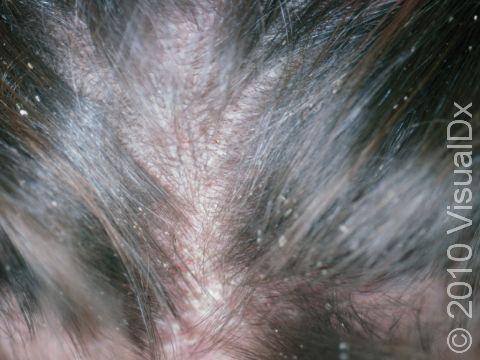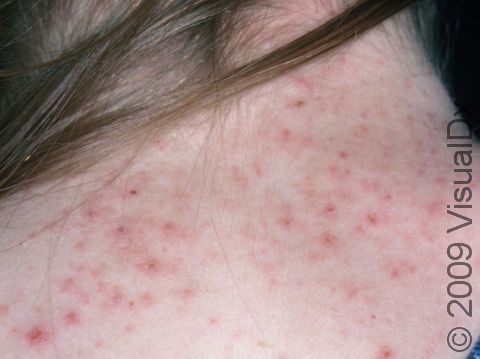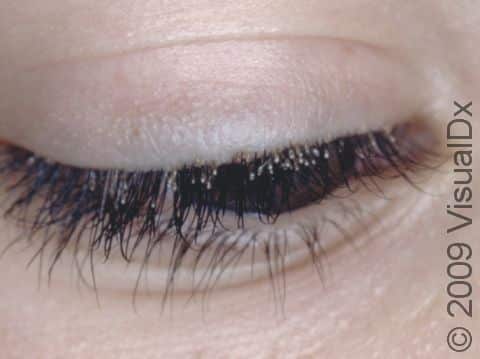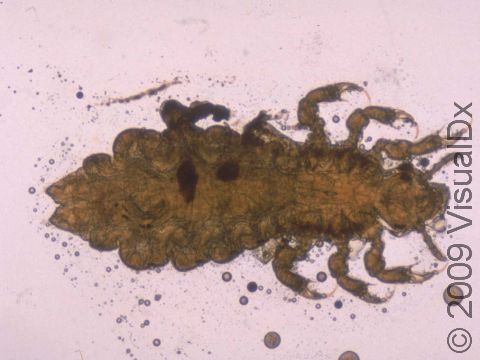Head Lice (Pediculosis Capitis)
Head lice are wingless insects that can infest the hair of the head and neck. The most prominent symptom of a head lice infestation (pediculosis capitis) is intense scalp itching.
The human head louse is a tiny insect that feeds on human blood. The female louse lays eggs (nits) on the hair shaft close to the scalp, and the nits become firmly attached to the hair shaft. The nits hatch about 8-10 days later, and the lice begin to feed. The nits can
Who's At Risk?
Head lice can occur in people of all ages and socioeconomic backgrounds. Males are affected somewhat less than females. Those with coarse, curly hair are less often affected because the lice are not able to properly attach to this type of hair. Children are most likely to become affected by a head lice infestation, and epidemics can occur in schools, day cares, and nurseries, but adults may also become infected, most often through contact with infected children. Nursing home epidemics have also occurred.
Signs & Symptoms
The earliest sign of infection is itching of the scalp. Lice and nits may be seen on the scalp and hair. Each louse is approximately 1-2 mm long and has 3 pairs of claw-like legs. The gray-white nits are smaller (0.5 mm), are firmly attached to the hair shaft, and are usually located close to the scalp. In longer-standing infestations, the nits may be farther away from the scalp. In addition, small bumps may be seen on the scalp, neck, and shoulders that are red or darker than the surrounding skin. If scratched aggressively, these bumps may become scabbed.
Self-Care Guidelines
In early infections, it may be difficult to spot the lice and nits. Search for lice and nits on wet hair using a fine-toothed comb (eg, a louse comb). Examine the scalp in bright light, using a magnifying glass if necessary.
The following self-care measures may be followed if you see head lice or nits:
- Use an over-the-counter medication for head lice exactly as directed. These medicines are insecticides and should not be applied in a larger quantity or more frequently than recommended. Most of these medications are not recommended for children aged younger than 2 years. However, ivermectin (Sklice) lotion is approved for ages 6 months and older. Note that not all insecticides are safe in pregnancy; check with your medical professional for more information.
- Before applying the medication, do not use conditioner on the hair, as this will coat the hair and protect the lice from the medicine. Use a nit comb after application. Also, do not wash the hair for 1-2 days after treatment.
- Another option is mechanical treatment. This means that all nits and lice are manually removed with a nit comb. This will require meticulous attention to detail and is time intensive. This process should be repeated at least weekly for 3 weeks to ensure all live nits and lice are removed. Professional lice and nit remover services may be available in your geographic area, but these services are costly.
- Wash household items such as bed linens, towels, and hats in hot water, and dry them using the hot cycle for at least 20 minutes.
- Wash any washable objects that the infected person has been in contact with in the past 48 hours in hot water for at least 5 minutes.
- Seal potentially contaminated nonwashable objects in plastic bags for 2 weeks. (The lice will die within 2 days, and the nits will hatch and die within 2 weeks.)
- Vacuum floors and any furniture that have been in contact with the infected person.
- Do not share combs, hairbrushes, hats, towels, bedding, clothing, headphones, stuffed toys, or other personal items with someone who has head lice.
Treatments
To make a diagnosis of head lice, the medical professional will look for a louse or nit on the scalp. They may shine a black light at the scalp called a Wood’s lamp, as the insects and eggs appear as fluorescent yellow-green spots under this light.
Once the diagnosis of head lice has been confirmed, the medical professional may recommend one or more of the following treatments in addition to the self-care measures outlined above:
- Permethrin lotion or shampoo
- Malathion (Ovide) lotion
- Spinosad (Natroba) cream
- Ivermectin (Stromectol) pills
Visit Urgency
See your medical professional if self-care measures have not successfully resolved the lice infestation. Also call your medical professional if you see any signs of bacterial infection on or near the head, such as redness, swelling, pain, or pus. If you are pregnant, check with your medical professional before using any head lice medicines.
References
Bolognia J, Schaffer JV, Cerroni L. Dermatology. 4th ed. Philadelphia, PA: Elsevier; 2018.
James WD, Elston D, Treat JR, Rosenbach MA. Andrew’s Diseases of the Skin. 13th ed. Philadelphia, PA: Elsevier; 2019.
Kang S, Amagai M, Bruckner AL, et al. Fitzpatrick’s Dermatology. 9th ed. New York, NY: McGraw-Hill Education; 2019.
Paller A, Mancini A. Paller and Mancini: Hurwitz Clinical Pediatric Dermatology. 6th ed. St. Louis, MO: Elsevier; 2022.
Last modified on June 14th, 2024 at 12:56 pm

Not sure what to look for?
Try our new Rash and Skin Condition Finder




